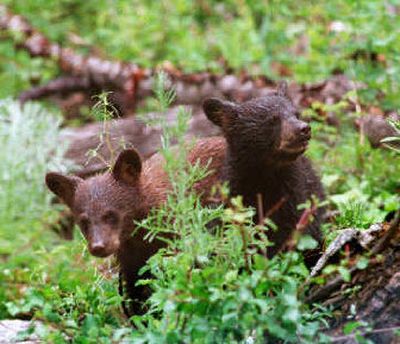Don’t feed the bears

“I noticed the smell first,” said Bonner County resident, John Stevens. “A bear’s breath is rank. Leaving for work at 2:30 a.m., I stepped onto the porch without turning on the yard light and found myself staring eye to eye with a black bear holding both my garbage cans. The bear dropped the trash and high-tailed it for the brush. I moved fast the other direction, to get back inside the house.”
Idaho is bear country. If you live here long enough, you’re bound to meet a bear. If you’re not careful, the meeting might be in your front yard. According to senior conservation officer Matt Haag, with Idaho Fish and Game, the top five attractants around the home are trash, bird feeders, dog food, compost piles and orchards.
Because black bears require about 20,000 calories a day, they move between higher and lower elevations in search of food. These omnivores are always hungry, and in years when the berry crop in the mountains is lean, bears move into areas they would normally avoid.
“This isn’t the worst year we’ve had for bear problems, but it is a bad year,” said Haag. “Since May, I’ve responded to 200 calls. My counterpart in western Bonner County has responded to even more.”
Most of the calls are about nuisance problems – a bear has been in the trash or destroyed bird feeders. But bears can be deadly. This year two families have lost a pet when their dogs died trying to drive off a bear.
“We had one bear that broke into the Black Bear Condos on Schweitzer,” said Haag. “It couldn’t figure out how to get out and trashed the unoccupied building. The same bear also had ripped open cars in search of food.”
Mature black bears range from 225 to over 500 pounds. Their claws and musculature is designed for rooting and overturning logs. If they get their claws into a seam, they can rip doors off of vehicles and siding off of buildings.
“Most of the calls we receive stem from people intentionally or unintentionally feeding the bear,” said Haag.
An aggressive bear that associates food with people will think nothing of banging on the front door and demanding more. Bears are both good problem solvers and opportunistic. If they find food at one home, they’ll try every home in the neighborhood. A 422-pound black bear recently killed in Porthill, Idaho, charged a home and then destroyed a screen door and damaged the door frame before the homeowner shot it.
Haag offers these tips for minimizing chances of attracting bears to a home:
“Keep trash inside in a secure area such as a basement. A tin-sided shop or shed will not keep a bear from ripping the building open. Take trash to the dump often or put it out on pick-up day only.
“The worst call I’ve had so far this season involved a family who stored a winter’s worth of their garbage outside,” said Haag. “I instructed them to take the trash to the dump or store it in bear-proof containers, preferably in a secure building. I received a call back a few days later because the bear destroyed the Rubbermaid garbage cans they’d purchased. The family next chose their canopy-topped pickup truck for trash storage. The bear destroyed both the topper and the bed of the pickup.”
“Feed your pets inside. If you must feed your animals outside, make it a single serving.
“Bird feeders should be taken down as soon as the grass greens up and not put back out until the first snowfall. Feeders should be installed a minimum of 12 feet in the air and at least 10 feet away from anything a bear can climb – a tree, a building, or a vehicle.
“Properly constructed compost piles shouldn’t smell. Contact a Master Gardener for tips on correct composting. Electric fencing works for deterring bears from around compost, gardens, beehives, and orchards. Fruit should be harvested as soon as it ripens. Clean up any fallen fruit from the ground.
“If you don’t want the fruit and wish to use it to feed the wildlife, haul it away to a forested area away from any homes,” said Haag.
“A bear can smell a barbecue grill from approximately a mile away. Clean your barbecue after each use and keep it covered. If possible, store the grill inside.
A bear that is used to people is dangerous – for people, property and pets. It creates hazardous situations for conservation officers and in at least three cases this season resulted in the bears being killed.
“Deterring the bear is the solution,” said Haag. “It isn’t really a bear problem. It is a human-conflict problem. The less people who feed bears unintentionally or otherwise the fewer problems will result.”